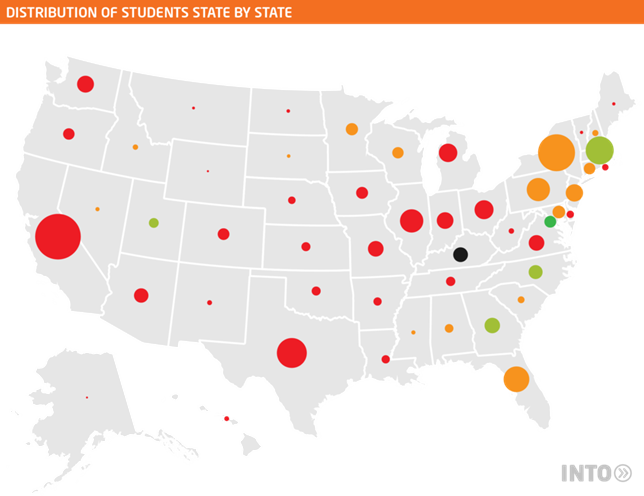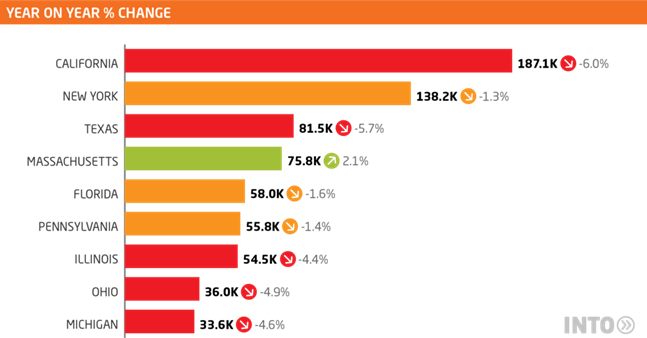SEVIS 2019: How changing international student enrollment patterns affect some states more than others (part two)

Photo by Greg Rosenke on Unsplash
The dip in international student numbers in the United States captured in the latest data from the Department of Homeland Security’s Student and Exchange Visitor Information System (SEVIS) is unsettling. A 3.1% decline in the number of international students in the US between December 2017 and December 2018 accelerates the 0.5% recorded in the SEVIS data from 2017.
As identified in the first part of INTO’s SEVIS analysis, nationwide declines in the number of international students are primarily driven by a combination of drops in language training and associate degree students and long-term decreases in the number of students coming from major source markets like Saudi Arabia, the latter of these changes informing the former. In our second look at the SEVIS data, we examine the ways in which these widespread trends impact on the distribution of international students at the state level, where those states with high proportions of language training and associate degree-granting institutions and/or which rely heavily on streams of international students from a single source country are disproportionately affected.

Source: SEVIS data December 2017 – December 2018
The size of the circles on the map correspond to the size of the international student population in each state, while the color indicates those states where populations have grown (green and black), remained stable (orange), or declined (red).
Declines in language training- and associate degree-seekers help explain why some states appear to suffer disproportionately.
All but six states experienced decreases in their shares of the total US international student population last year. While the international student populations in most states along the eastern seaboard remained stable or increased, even traditionally popular student destinations experienced declines—some significantly higher than the average drop registered across the Union. Contextualized within widespread decreases in the number of English language students and associate degree-seekers as well as long-term declines from key source markets, the disproportionate decreases of certain states’ international student populations begin to make sense.
In 2018, California and Texas, two of the three most popular study destinations in the United States, experienced drops of 4.3% and 5.4% in their respective international student populations—declines nearly twice as large as the national 3.1% dip in the number of international students. However, these declines do not indicate that California and Texas have lost their appeal to international students – both are still home to very large populations of students from around the world. Rather, they indicate that both states are more susceptible to widespread decreases in the number of students pursuing language training and associate degrees in the US due to the larger-than-average proportion of community colleges and language training institutions they house.

Source: SEVIS data December 2017 – December 2018
Of the 398 institutions with Carnegie Classifications in California, 127, or 31%, are associate degree-granting community colleges. Meanwhile, 71 of 228, also 31%, of Texan institutions with Carnegie Classifications are community colleges. California’s and Texas’s high proportions of community colleges are significantly greater than that of most states. On average, 13% of a state’s institutions with Carnegie Classifications are community colleges—less than half of the proportion of such institutions that exists in California and Texas.
Moreover, 20% of the international students studying in California are pursuing associate degrees, while 22% of international students in Texas are doing the same. Compare this to the 12% of international students pursuing associate degrees in Iowa or the 1% of international students doing so in Kentucky, and it becomes clear that the disproportionate decreases in the number of international students pursuing their education in Texas and California is not the result of these states having lost their appeal as study destinations. Rather, it demonstrates that these states are more susceptible to the significant decrease in the number of international students choosing the US as their destination for language training and associate degree pursuit.
A lack of international student diversity impacts on some states and institutions more heavily than others.
In addition to decreases in the number of international students choosing to pursue language training and associate degrees in the US, a reduction in the number of international students coming from Mexico has affected Texas’s international student population more than other states. This drop-off in Mexican student enrollments is linked to a decrease in Proyecta 100,000 sponsored students enrolling in language programs, and it impacts on Texas more severely than other states because these students represent the third largest international student cohort in the state—accounting for 7% of the state’s international student body. Nationally, Mexican students account for less than 1% of the total international student population.
Of course, it also follows that Texas stands to benefit disproportionately as enrollments from Mexico rebound—a likely long-term outcome given that many Mexican students qualify for in-state tuition at public universities in the state. However, the case of Texas exemplifies a challenge facing many states: A lack of international student diversity means that some states’ international student populations are disproportionately susceptible to shrinkage caused by long-term decreases in the numbers of international students arriving from a small range of key source countries.
Take Idaho, for example, where a 2.7% decrease in the number of international students from 2017 and 2018 corresponds to an ongoing decline in the number of Saudi Arabian students arriving in the state (the financial repercussions of which were widely reported at the time). Since 2014, Idaho has experienced a 76.4% drop in the number of Saudi students enrolled at in-state institutions, with 2018 bringing a further 37.2% decrease in the proportion of these students. Saudis constitute the second largest group of international students pursuing their education in Idaho, amounting to 7.96% of the state’s total international student population.
This proportion is significantly greater than that of other states, such as New York, where Saudis account for just 1% of the total international student population, or Nevada, where they constitute less than 1% of the international student share.
A 2.7% drop in the number of international students coming to Idaho does not indicate that it has become less popular as a study destination, but that its reliance on this single stream of international students has resulted in increased vulnerability to the ongoing decline in the number of students coming to the US from Saudi Arabia.
Zooming out: Four-year trends by source country
Despite concerns warranted by the decline in the number of international students in the US in 2018, one year of declines across the top ten source markets of international students does not constitute a long-lasting negative trend, nor does it confirm that the US has lost its prestige as a study destination for students from around the world. Consider the last four years of international enrollment data. Saudi Arabia, South Korea, and Japan are the only big senders of international students to the US that have seen on-going, year-over-year declines of 47.3%, 29.8%, and 22.7%, respectively.
Moreover, long-term trends from these countries predate the 2016 election, indicating that they are driven as much by external phenomena of demographics, economics, politics, and increases in local provision of higher education opportunities as they are by US immigration policy and concern about the US as a study destination.
In the case of Saudi Arabia, cuts in government-sponsored scholarship programs have led to significant year-over-year declines in the number of international students sent to the US. However, with a young population and significant capacity issues in country, Saudi Arabia may well send reverse recent trends and send larger numbers to the United States in years to come. Meanwhile, demographic shifts, additional capacity, and slowed economic growth in Japan contribute to the declines in the number of Japanese students coming to the US.
None of this is to say that students feeling less welcome, less secure, or less valued in the US has not contributed to uncertainty—indeed, there is evidence that such a sentiment has driven recent declines from India. However, even India, which experienced a dip of its own for international students sent to the United States between 2010 and 2012, when numbers dropped from 70,500 to 68,000 students, has posted impressive year-on-year growth amounting to 55.5% over the past four years.
SEVIS: The importance of context
Analyzed in a vacuum, the latest SEVIS data seems to confirm that years of untrammeled international enrollment growth are behind the US, and that even those states whose international student populations have consistently grown may have lost their shine. However, contextualized within the last four years of international enrollment trends, the most recent SEVIS release does not spell doom. It simply confirms that the international education landscape in the US is changing.
While fewer students travel to the US for language training and associate degrees than did four years ago, they continue to pursue undergraduate and graduate study in similarly sized, even larger cohorts. Where certain states and institutions experience larger declines than others, it seems to reflect the breadth of their provision or their relative dependence on certain sending countries—not a decrease in their popularity as study destinations.
The global pressures driving student mobility continue to intensify and, as the world’s most popular student destination, the United States remains ideally placed to meet the need. However, with increasing global competition, a complex and rapidly evolving environment, and more higher education institutions entering the fray, recruiting international students as an individual institution is a daunting endeavor. Nevertheless, while there are new challenges facing universities attempting to navigate the international recruitment landscape, there are also major opportunities. The question is: How will your institution address them?
This two-part SEVIS analysis post features data collected by INTO’s market and analytics team, which is comprised of seasoned analysists positioned around the world who collate data from sources like SEVIS, IIE’s Open Doors report, IPEDS, the National Student Clearinghouse, and the US Department of State, to name a few. In addition to this high-level analysis, the team engages in research at the institutional level and can determine the levels at which universities recruit international students in comparison to their peers. If you are interested in a personalized data surgery, please reach out.